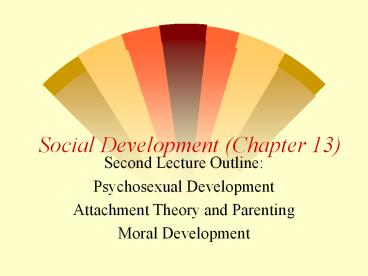Social Development (Chapter 13) - PowerPoint PPT Presentation
Title:
Social Development (Chapter 13)
Description:
Social Development (Chapter 13) Second Lecture Outline: Psychosexual Development Attachment Theory and Parenting Moral Development – PowerPoint PPT presentation
Number of Views:329
Avg rating:3.0/5.0
Title: Social Development (Chapter 13)
1
Social Development (Chapter 13)
- Second Lecture Outline
- Psychosexual Development
- Attachment Theory and Parenting
- Moral Development
2
Freuds Psychosexual Theory
- Oral stage (birth to two years)
- Pleasure from sucking and oral activity
- Anal stage (two to four years)
- Urination and defecation
- Phallic stage (4 to middle childhood)
- Oedipal (male) and Electra (female) conflict
Desire opposite sex parent, fear wrath of same
sex parent, identify with same sex parent - Latency and Genital (adolescent) phases
3
Freud and the two problem women in his life
4
(No Transcript)
5
(No Transcript)
6
Attachment theory
- Emotional bonds between people have adaptive
significance, develop through an interactional
history, and influence personality development - History Spitz and WWII orphans Harry Harlow
and rhesus monkeys Lorenz and his ducks Genie
and deprivation sabre-tooth tigers - Bowlby Attachment, Separation, and Loss
7
Maasi in africa Attachment theory is
cross-cultural
8
Patterns in Infancy Ainsworths Strange
Situation
- Three patterns which differ on proximity-seeking
and distress resolution - Avoidant (A) No distress or proximity-seeking,
no distinction between mother and stranger - Secure (B) Distress resolved, proximity-seeking
- Resistant (C) Distress not resolved, ambivalent
proximity-seeking
9
Attachment in context
- Parental work status does not predict attachment
- Emotional adjustment of the parent (e.g., family
stress and conflict) is important - Quality of non-parental care is important
- Relationship quality becomes internalizes and
influences later adult and romantic relationships - AAI Dismissing, Autonomous, Preoccupied
10
(No Transcript)
11
Parental Styles
- Authoritarian Firm, punitive, unsympathetic,
and negative - Children can learn to be sneaky and externally
controlled with low self-esteem - Permissive Freedom, no rules or discipline
- Children can learn to be impulsive, get in
trouble - Authoritative Firm but understanding
- Children help make the rules, high self-esteem
12
Moral Development
- Kohlbergs model I leave exam in room
- Preconventional morality age 7-10 Punishment
and obedience - Conventional morality age 10-16 Social rules
are internalized conscience - Post-conventional morality 16 Internal moral
principles outweigh social rules - Gilligan Justice and respect are male-, care
and compassion are female-oriented
13
Scenario I In Europe, a woman was near death
from a very unusual kind of cancer. The doctors
thought that one drug -- a form of radium
discovered by a druggist in the same town --
might save her life. The druggist paid 400 for
the radium and charged 4,000 for a small dose of
the drug. Heinz, the sick woman's husband, went
to everyone he knew to borrow the money and
tried every legal means, but he could only raise
2000, half of the drug's selling price. Heinz
pleaded with the druggist, explaining to him that
his wife was dying. He presented several options
to the druggist sell the drug to Heinz at a
cheaper price, let Heinz pay for the drug in
installments or let Heinz pay for it at a
later date. But the druggist said, "No, I
discovered the drug and Im going to make money
from it." Heinz is now considering breaking into
the drug store and stealing for his wife.
Question 1 Should Heinz steal
the drug? Question 2 Should
Heinz steal the same drug if the dying person is
a "not particularly close" friend,
rather than a spouse or relative?































